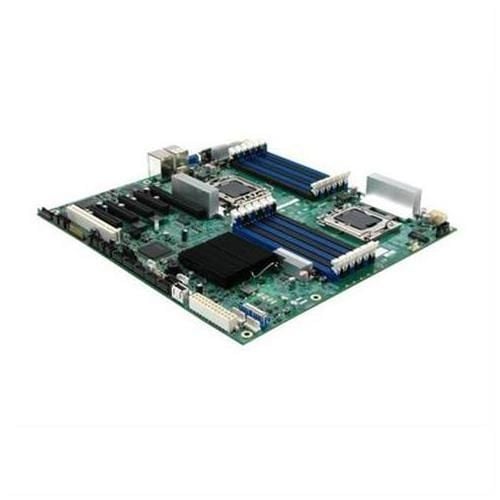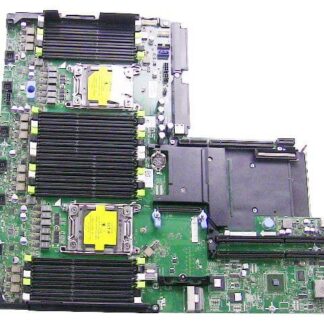Motherboard
A motherboard connects all the electronic components of a computer together. System boards vary widely depending on the types of components that they support. At the very basic, a motherboard supports a single CPU type and has a list of memory slots. Motherboard manufacturers will provide a comprehensive list of component compatibilities.
Common features or internal components to understand when choosing a system board are:
- Form factor is a simple reference to the layout and dimensions of the main circuit board. The common ones are ATX, Mini-ITX, and MicroATX.
- BIOS and UEFI BIOS is the firmware that manages your PC outside of the operating system.
- I/O Shield has cutouts for all ports on specific PC motherboards.
- Chipsets provide pathways between components and subsystems in a PC. Chipsets will define the board family, processor lines, and features that the system board can carry.
- DIMM (dual in-line memory modules) slots accommodate the system’s RAM with levers to lock it in.
We have different types of motherboards or form factors depending on your needs.
ATX Motherboard
Advanced Technology Extended or standard ATX motherboards are an improvement on the previous generation of AT motherboards. They are smaller and support the interchangeability of internal components. The connector system was vastly improved to support different add-ons.
Micro Motherboards
Another name for these main circuit boards is low profile extension motherboards or LPX motherboards. A distinguishing feature of micro motherboards is that input and output ports are found at the back. They support a riser card to add more slots.
The downsides of the boards – lack of a real AGP slot and impeded airflow by the riser – led to the extinction of the LPX boards.
BTX Motherboards
Balanced Technology Extended or BTX motherboards were designed to eliminate scaling and thermal issues associated with the latest technologies. The newer technologies require more power for improved performance.
BTX boards have a lower profile, an improved thermal design for better cooling, and an innovative structural design to eliminate the strain by capacitors and heat sinks. These motherboards became useful for system integration and enterprise use on rack mounts.
Mini ITX Motherboards
These are low power motherboard small form factors. The Mini ITX boards are able to cool effectively due to their lower power consumption needs.
These boards have four mounting holes that align with similar holes in ATX motherboards as well as expansion cards and backplate. The use of Mini ITX boards can happen interchangeably with all ATX variants.
Yet another way of categorizing motherboards is dependent on the type of processor socket/CPU socket. A processor socket is a connector on the main circuit board that houses a CPU and forms the electrical interface. The common types of sockets are Pin Grid Array (PGA), staggered pin (SPGA), land grid array (LGA), zero insertion force (ZIF), AMD 3 socket (socket AM3), and LFA 1366 or socket B.
With the above information, you are able to choose a motherboard that meets your needs in building a dream personal computer. Good modern motherboards must be compatible with the internal components of a computer system and enhance computer speed. The role of a system board in the efficient and high-speed performance of a computer system cannot be overstated.
Showing 1–12 of 588 results
-

P04664-001 HP Motherboard For Proliant Dl325 Gen10 G10 | Refurbished
Request for quote -

P07018-001 HPE Motherboard For Proliant Dl325 Gen10 G10 | New Bulk Pack
$1,237.00 -

P07018-001 HPE Motherboard For Proliant Dl325 Gen10 G10 | Refurbished
Request for quote -

PXXHP Dell CPU System Board PCI Riser Card for Poweredge R620 Server | Refurbished
Request for quote -
136271347551395b830043f.jpg)
R872J Dell System Board For Latitude D630 Laptop. New Bulk Pack.
$140.00 -
136271347551395b830043f.jpg)
R872J Dell System Board For Latitude D630 Laptop. New pull.
$35.00 -

RFX9G Dell Motherboard For Precision R5500 Series Workstation PC. Refurbished.
Request for quote -

Supermicro X8DTN+ Intel 5520 Chipset Server Motherboard |Refurbished
Request for quote -

Supermicro X8DTU-F LGA 1366 Intel 5520 Chipset Intel Xeon DDR3 12x DIMM 6x SATA2 3.0Gb/s Motherboard | Refurbished
Request for quote -

T5XFM Dell System Board PCI for Core I7 3.1GHZ I7-4510U CPU XPS 12 2-IN-1 Ultrabook | Refurbished
Request for quote -
1362820880513aff108683a.jpg)
V000095500 Toshiba Laptop Board For Satellite A205 Series. New Bulk Pack.
Request for quote -
1362822782513b067e3bc7d.jpg)
V000138400 Toshiba System Board For Satellite L300 Series Laptop. New Bulk Pack.
Request for quote
Showing 1–12 of 588 results



I have ordered disks from you a couple of times.
Review of 2/12/2024, reflecting an experience on 2/12/2024 by Neil M